Kickapoo Joy Juice was a fictional moonshine created by Al Capp, but there were real Kickapoo ‘medicines’ that sold like wildfire in the late 18th and early 19th centuries.
Crowds flocked to the medicine shows.
The Kickapoo Indian Medicine Company boosted sales with traveling medicine shows. Part carnival, part sales pitch, they featured Indian ‘agents’ or ‘professors’ making outlandish claims for quack cure-alls in between Indian acts.
The Kickapoo Indian Medicine Company’s medicine shows were the biggest and most successful in the United States. They were the brainchild of a New Haven peddler and a bogus Texas frontiersman who capitalized on the American belief that Indians had a deep knowledge of natural medicine.
Capp’s Kickapoo Joy Juice was so potent the fumes alone could melt the rivets off battleships. Kickapoo Cough Cure and Kickapoo Sagwa could cure just about any ailment – or so claimed the New Haven entrepreneurs who concocted the products.
Patent Medicines
English patent medicines came to the British colonies from England. They were made under grants, or ‘patents of royal favor,’ to purveyors of medicine for the royal family.
Americans soon discovered it was cheaper to make their own patent medicines than import them. They didn’t trust doctors, for good reason, and were susceptible to peddlers’ claims of miracle cures. By the 19th century, traveling patent-medicine salesmen brought medicine shows along with them to attract customers.
John E. Healy led a checkered career before he stumbled on the idea of an Indian medicine show. He had been a drummer boy in the Union Army during the Civil War, a door-to-door salesman of vanishing cream, a purveyor of ‘King of Pain’ liniment and proprietor of an Irish minstrel show. He hooked up with Dr. E.H. Flagg, a Baltimore peddler who played the violin on street corners to help sell his Flagg’s Instant Relief.
Flagg’s Instant Relief was soon renamed Kickapoo Indian Oil. In the fall of 1879 the two men hired Charles Bigelow to take the Kickapoo Indian Oil show on the road. He had left the family farm in Bee County, Texas, to tour with a phony Indian medicine man who called himself ‘Dr. Yellowstone.’ Bigelow called himself ‘Texas Charlie,’ wore a sombrero over his long flowing hair and spewed humbug about Indian medicine.
Soon Flagg was out of the business and Healy and Bigelow were partners. As acolytes of P.T. Barnum, they shamelessly and tirelessly ballyhooed their products.
Kickapoo Sagwa
The Kickapoo Indian Medicine Company reassured its customers that medicines made of ‘roots, barks, twigs, leaves, seeds, and berries are the most beneficial, because they assist Nature in the right way to make her own cure.’
Kickapoo Indian Oils were ‘quick cures for all pains,’ and the Kickapoo Indian Cough Cure could cure ‘all diseases of the throat and lungs.’
They promised their most popular product, Kickapoo Indian Sagwa, would purify the blood and cure all diseases of the digestive system. They advertised it as a product of roots, herbs and bark, but a rival claimed it was really a mixture of stale beer and aloe.
Buffalo Bill Cody endorsed Indian Sagwa in a patently false claim:
Kickapoo Indian Sagwa … is the only remedy the Indians ever use, and has been known to them for ages. An Indian would as soon be without his horse, gun or blanket as without Sagwa.
Healy and Bigelow opened a storeroom for their ingredients in a Providence hotel, then moved on to Boston where they produced their first medicine show outside of a railroad station. During the winter the show moved to the former Aquarium in New York City.
Principal Wigwam
From 1881-84 the Kickapoo Indian Medicine Company was headquartered in Boston, then it moved to New York for three years and in 1887 settled its ‘Principal Wigwam’ in New Haven before a final move to Clintonville, Conn., in 1901.
Healy and Bigelow weren’t the first to stage Indian medicine shows, but they were the best. The two men knew how to capitalize on America’s infatuation with the rapidly closing Western frontier.
Their traveling medicine shows were popular entertainments when they came to town, featuring fake war dances and marriages, dances, acrobatics, vaudeville acts, fire eaters, rifle shooting, ventriloquists and trained dog acts. The only thing they didn’t feature were Indians from the Kickapoo tribe in Oklahoma. Many came from small Iroquois tribes in New York and Québec or Plains Indians lured away from other shows.
The Kickapoo Medicine Show
An Indian agent in buckskin or a tuxedoed ‘professor’ would hold forth until the war whoops of Indians interrupted his lecture. They would come running down the aisles with baskets of Sagwa, Indian Oil, Cough Cure and Worm Killer, which they sold to the audience.
In another version, the agent would stand on an open platform with an Indian panorama as a backdrop. He would introduce the Indians, seated in a semicircle, and give short histories of their lives. Then one of the Indians would deliver a speech in impassioned ‘Kickapoo,’ which the agent ‘translated,’ though he had no idea what the Indian was saying. Sometimes the speech would have the seated Indians convulsed with laughter. Then a vaudeville show would follow, interrupted by as many sales pitches as necessary.
John Johnson
One of the show’s most popular performers was Dr. John Johnson. He looked and acted like a medicine man, and for more than 20 years he believed he was. Johnson, however, had been kidnapped as a child from Saco, Maine, by Mi’kmaq Indians from Nova Scotia in 1834. He learned traditional Indian medical practices and the Indians viewed him as a medicine man. Later in life he learned his true identity, but he continued with the medicine show for decades.
By 1890, 800 Indians spent the winter in the Principal Wigwam—actually several buildings along the river — in New Haven. Healy and Bigelow contracted with federal Indian agents to send hem performers for room, board and $30 a month. The government delivered as many as 200 Indians at a time from their reservation to the Principal Wigwam.
The shows were so successful that Bigelow and Healy had close to 100 troupes on the road at one time. They traveled as far west as Chicago and as far south as the West Indies. Their success spawned cheap imitators, who claimed the Kickapoo name but offered lame entertainment and dangerous medicines.
Pure Food Law
The Pure Food and Drug Act of 1906, along with the advent of the motion picture, put a slow end to the traveling medicine show.
At first the Kickapoo Indian Medicine Company praised the new law for putting out of business ‘fake ‘patent medicines’ and so-called ‘remedies’ containing dangerous drugs. And yet the Kickapoo Cough Cure was deemed ‘misbranded’ under the Act in 1911. The reason? It contained far more alcohol than indicated on the label.
The Kickapoo Medicine shows continued into the 1920s, when the owners sold out for a half million dollars.
A few legitimate patent medicines survive to this day: Listerine, Bayer Aspirin, Milk of Magnesia and Ex-Lax. Richardson’s Croup and Pneumonia Cure Salve now goes by the name Vick’s VapoRub.
With thanks to Step Right Up by Brooks McNamara. This story was updated in 2024.
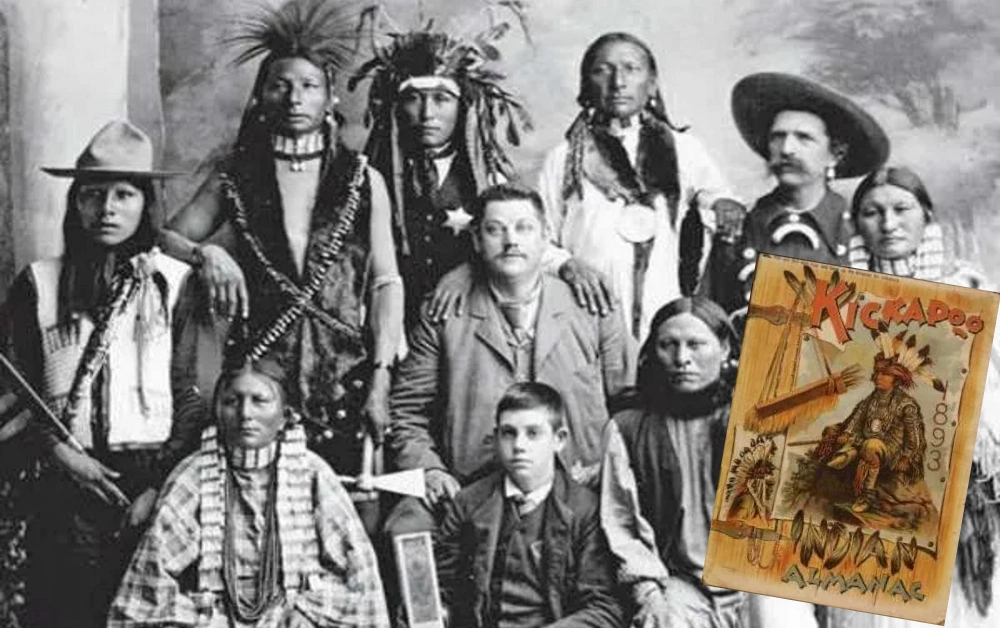
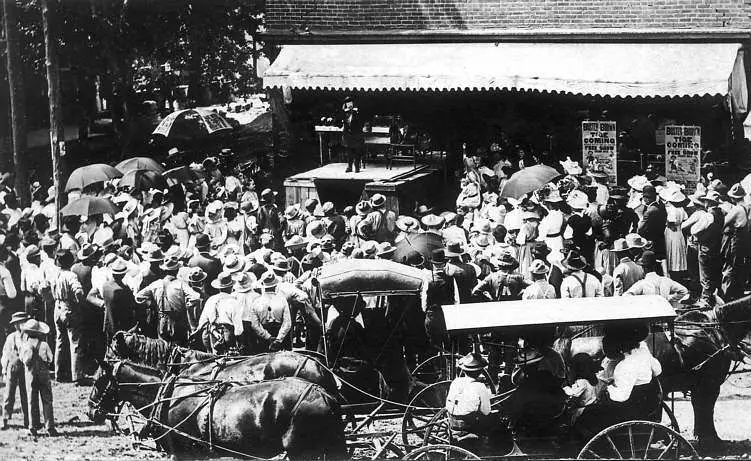
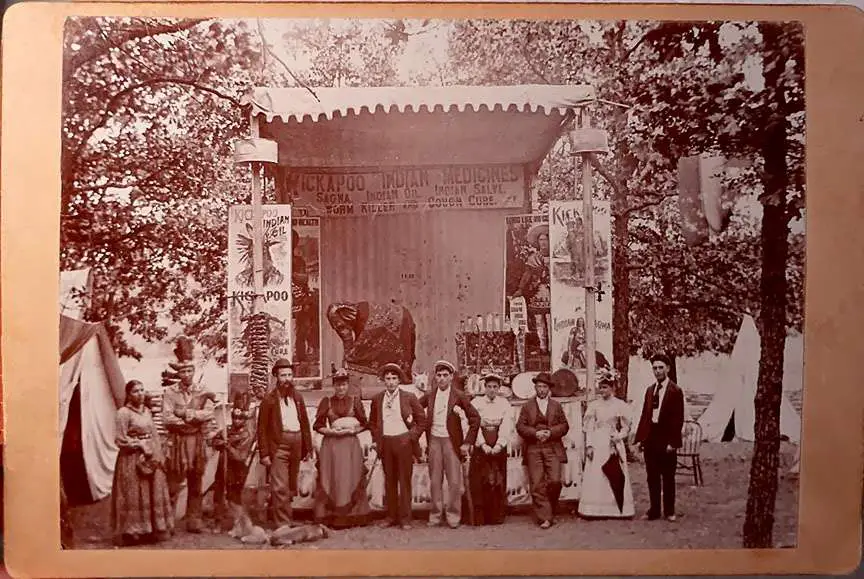
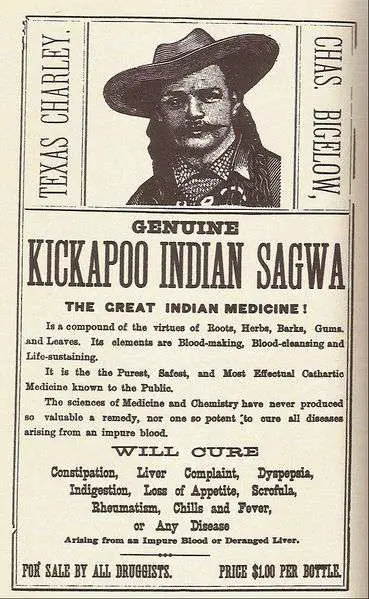
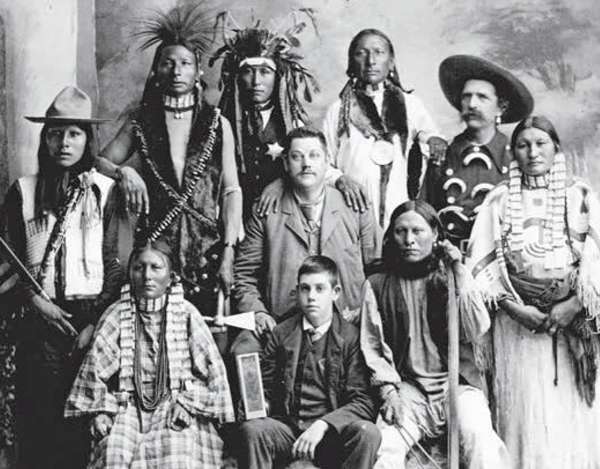
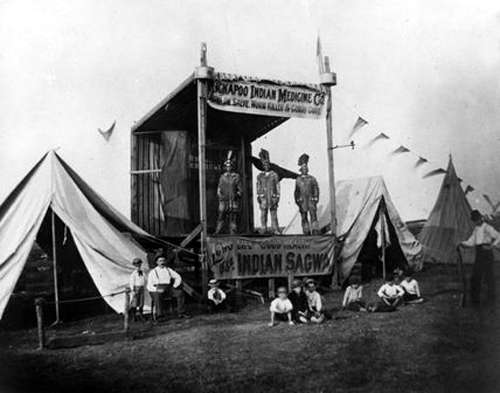
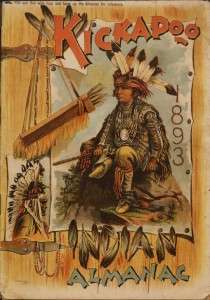

10 comments
Great write-up, and thanks for the inclusion! Kickapoo is still very much alive, and available! Check it – http://bit.ly/kickapooisthesodaforme and http://drinkkickapoo.com! 🙂
The era of the Kickapoo medicine shows was the late 19th and early 20th Centuries, not 18th & 19th.
[…] oil was marketed as a patent medicine called ‘Seneca Oil,’ after the local Indians who had shared its healing properties with the […]
Did it have color to it just a question we found a bottle with pinkish stuff in it with a cork we are redoing a room and all the the walls were like a thin layer of concrete is was in the wall
We’re not sure…
Dear A person in charge
Nice to meet you.
We are a company producing a Documentary TV program in Japan.
We want to use the photograph in the HP of your company.
It is a photograph of “Crowds flocked to the medicine shows” and “A Kickapoo Medicine Show company in front of a stage” in the page of “The Kickapoo Indian Medicine Company of New Haven Entertains the Masses (But Doesn’t Cure Them)”.
Please teach copyrights.
How are you usable?
We are look forward to hearing from you.
Sincerely yours,
Media Mettle Inc.
Ikuko Sugita
[…] Milk Carts. It had a Committee on Quackery to educate the public about unscrupulous fakirs who sold patent medicine. The Department of Sanitation had a Committee on Milk with subcommittees on Butter and Ice Cream. […]
I’m a relative of John Johnson and would like a printed copy of this article. Is it possible to print at home or obtain from the society? My home printer will use 79 pages to print this.
We suggest you copy and paste it into a word file and print it out that way.
[…] eventually surpassed cannabis as the agricultural fiber of choice. But patent medicine makers continued to use cannabis as an active ingredient in over-the-counter remedies. People used it as a […]
Comments are closed.